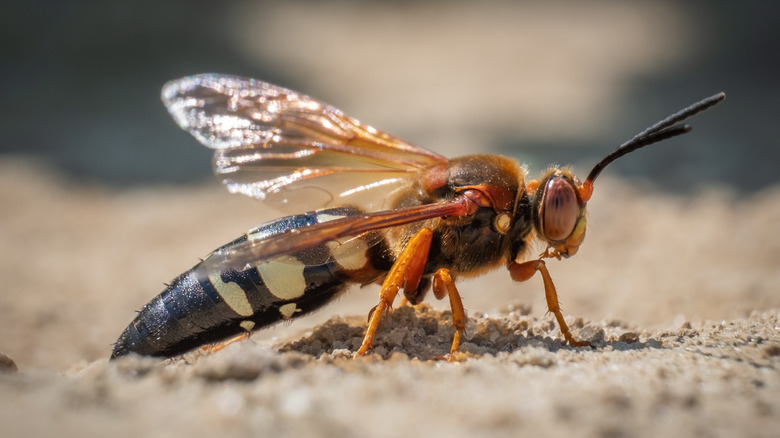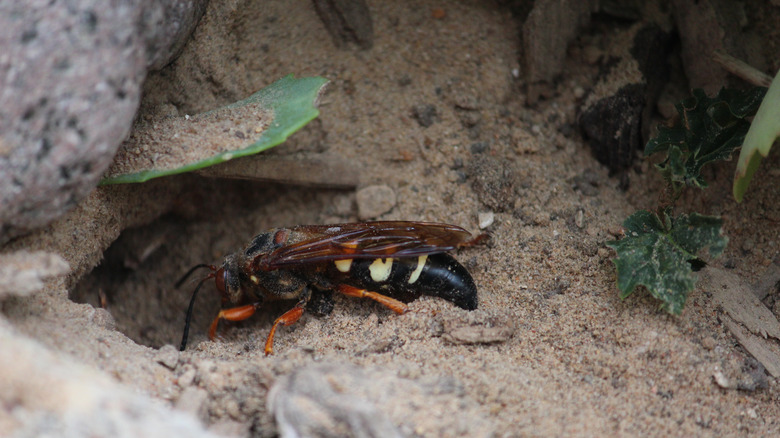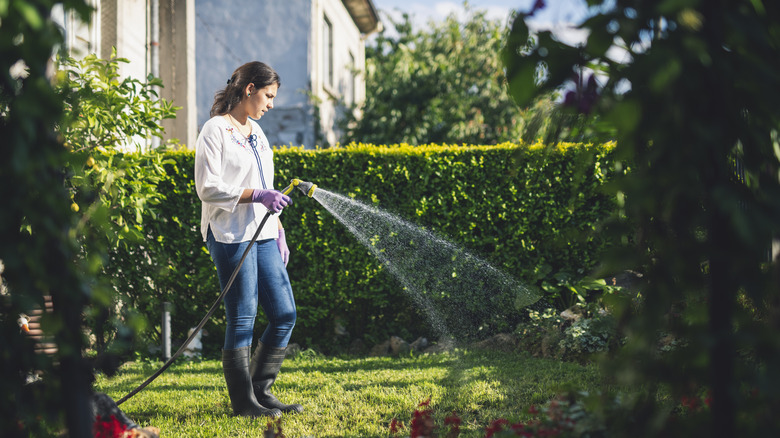Signs The Cicada Killers In Your Yard Have Gone From Helpful To Harmful
We may receive a commission on purchases made from links.
Some cicadas emerge annually, but in 2024, cicadas that emerge every 13 and 17 years are coming out from underground. It's the year of the cicada, and people are getting ready to be swarmed. While these summer insects don't harm humans or pets, they can pose a threat to your yard. They can also damage young trees when they lay their eggs in the branches. To do so, they cut holes into the wood and deposit about 20 eggs in each hole. While that might not seem too bad, one cicada will lay around 600 eggs. Because of this, some folks will try to attract cicada killer wasps to their yards. These large wasps sting cicadas and then move them into their underground tunnel system to feed their young. While effective at keeping the cicada population down, these wasps can wreak havoc. You will know that they may be causing more harm than good when you notice large amounts of dirt displaced in your yard.
Cicada killer wasps move the soil to build tunnels, and not only is it messy, but their aggressive excavating can harm the appearance of your paved structures and plants. For example, displaced soil can lead to patio or sidewalk damage or to plant death due to damaged roots. The harm done by the wasps can be worse than that done by the cicadas. Here is a closer look at how to know cicada killers are harming your yard and how to get rid of them.
Signs that cicada killers are damaging your yard
Cicada killer wasps prefer to live underground. The female wasps dig out a labyrinth of tunnels to provide shelter for the colony's young, and while doing so, they move a lot of dirt. This can make your yard look messy as large mounds begin to litter the lawn, flower beds, or sidewalks. But sweeping away a pile of dirt will be the least of your worries. The tunnels are 30 to 70 inches in length and run more than a foot below the surface. Displacing that amount of dirt can suffocate surrounding vegetation if it's not cleared up quickly, especially on the grass.
The cicada killer tunnels can also cause damage to structures such as brick patios, stepping stones, or brick garden walls. If the patio is built on a sand base, the blocks can shift when a tunnel is made. If you don't have sand in your yard, you don't have to worry as much about structural damage. But if your patio pavers are safe, your flower beds or vegetable patches might not be. These wasps might cut through roots to create their tunnels, which can damage vulnerable plants such as seedlings or plants that are just developing their root systems. If you see any signs of damage, it's time to get rid of the wasps.
Displace cicada killers with water or pesticides
You can get rid of cicada killer wasps with a few simple solutions. If you only have a few in your yard, then your first course of action should be to use water. These wasps don't like to work with wet soil, so consistently watering the area may convince them this isn't a hospitable area to raise their colony and they may move on. However, if they are burrowing in your grass, you should switch tactics and instead focus on making it as thick and lush as possible. The wasps prefer to dig where there isn't a lot of turf since the soil is easier to move, so if you don't mind waiting one or two seasons to eradicate your problem, your best course of action is to fertilize and water your lawn routinely to make the turf thicker and less appealing.
If you're overrun with wasps and want to get rid of them immediately, consider using Sevin pesticide. You can use either the liquid or granular form, and you can get it for as little as $7 in stores like Home Depot. According to North Carolina State University Extension, this is one of the most effective pesticides for cicada killer wasps. Be sure to follow the instructions on the package and ensure that pets and children aren't exposed to the pesticide.


